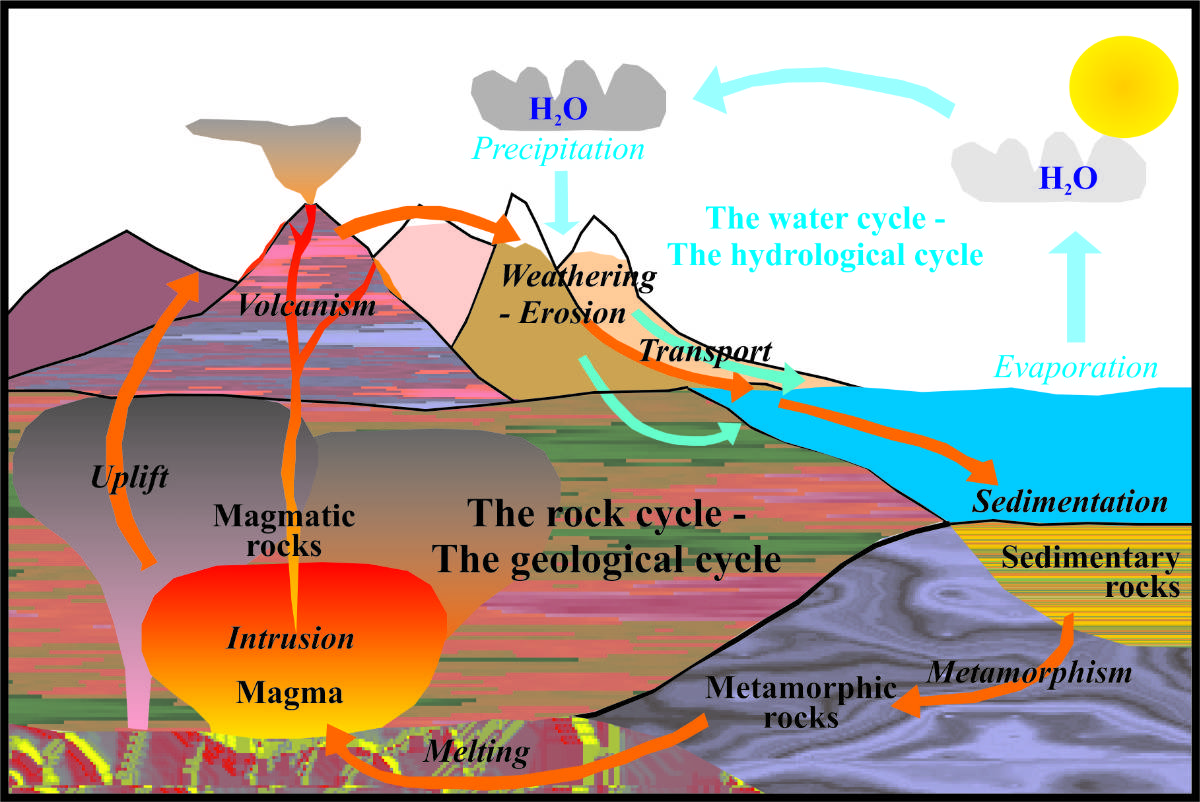The bedrock cycle
Rocks are part of nature's great cycle. Through various geological processes, one type of rock can change into another in a cyclical process, the so-called rock cycle. Examples of geological processes are weathering, sedimentation, melting and volcanism.
The rock cycle
The continental plates are torn apart and collide because of movements inside earth. These movements occur as a result of the heat constantly building in the earth’s core and mantle. The heat stems from active radioactive processes.
When two continental plates collide the material is pushed upwards and downwards. Those that are pushed upwards form mountain ranges while those pushed downwards are exposed to high pressure and eventually high temperatures because of the weight of the overlying masses of rock. The material starts warming up and melting.
When an ocean plate consisting of heavy rock collides with a continental plate consisting of lighter rock, it will be pressed down below the continental plate because of its weight. This is called subduction. Once the plate has sunken deep enough into the mantle it will start melting into warm magma.

Magmatic rock
Warm magma is lighter than its surroundings and thus starts a slow rise. On the route upwards it may heat the sides. Occasionally it may blend with the surrounding rock or rip off and bring on its way parts of it. As long as the density of the magma differs from the surroundings it will continue upwards. At the end this might lead to volcanic eruptions if the magma reaches all the way to the Earth’s surface. But the magma may also remain and harden further down in the crust. Magmatic rocks are formed from solidified magmas.
Metamorphic rocks
Rocks consist of different materials with dissimilar melting or fusing-points. Rock subjected to high pressure will not be melting evenly but some minerals will melt while other will remain in the form of crystal. New, transformed rock will hence be formed, so-called metamorphic rocks.
Rocks formed at great depth (because of stopping on their way upwards) will eventually lay bare through the land uplift and erosion.
Sedimentary rocks
Rock on land is continuously exposed to wear and erosion. Rocks are worn down to fine material carried off into the sea by water and wind. The material is deposited into thick layers of sediment on the bottom of the sea. As the layers of sediment are growing thicker they are compressed by their own weight. In due course the layers of sediment are transformed into sedimentary rocks.
The layers of the Earth
The Earth is divided into layers of different kinds. The outermost 50 to 60 kilometres thick layer is called the crust.
The crust consists of large plates floating around on the partially melted mantle. The mantle is located below the crust and reaches almost 2,900 kilometres into the core.
Earth’s plates are divided into oceanic plates and continental plates. The oceanic plates consist of heavy rocks (solidified rock) on the bottom of the oceans. The continental plates consist of lighter rocks and make up the ground we thread on.
The core is the innermost layer, and is very hot. The core is divided into an inner and an outer core. The temperature in the inner core is 6,000 degrees C. It is solid despite the high temperature, because of the high pressure in the core. In the outer core, closest to the mantle it is 4,000 degrees C. All the rock there is liquid.

